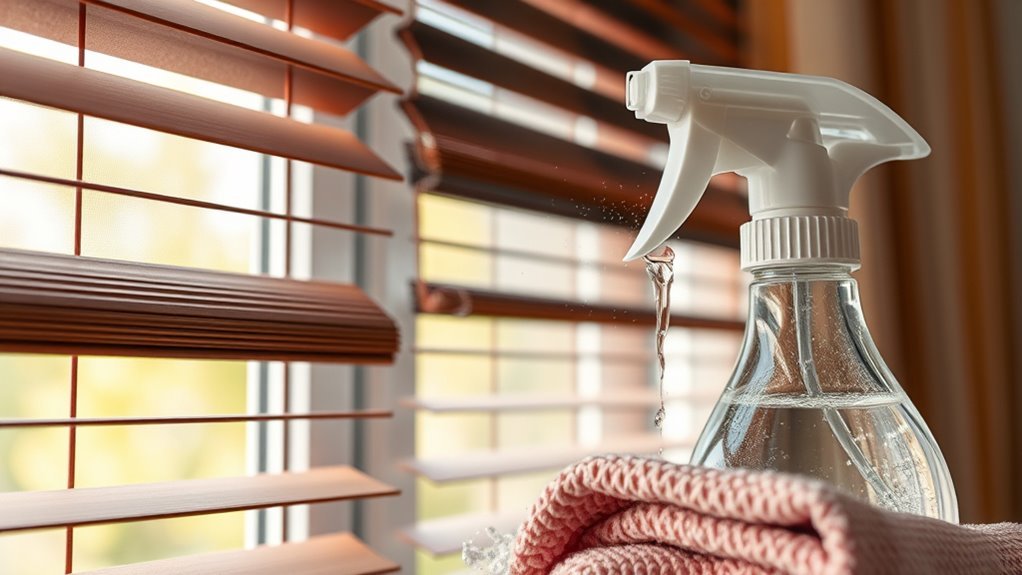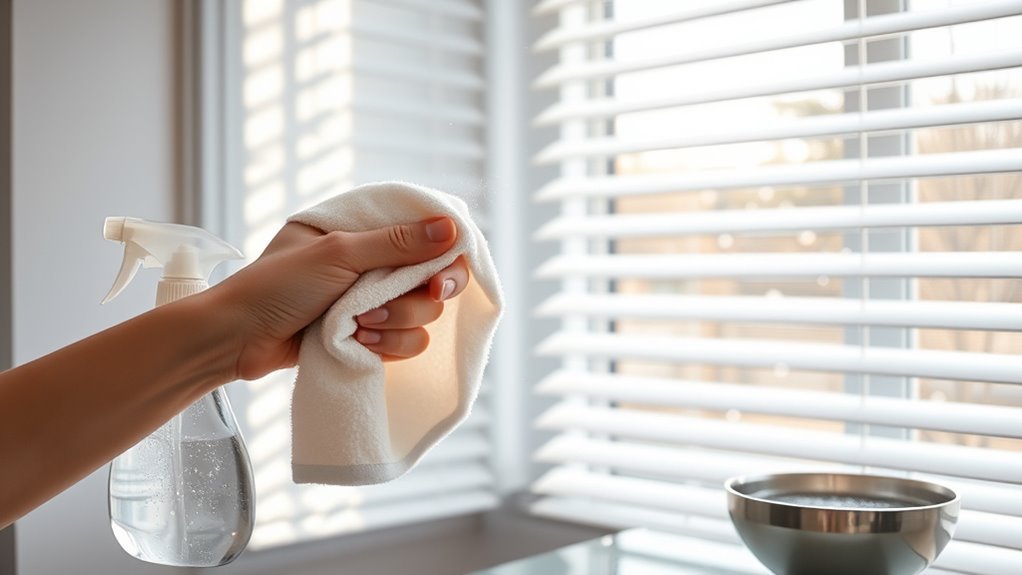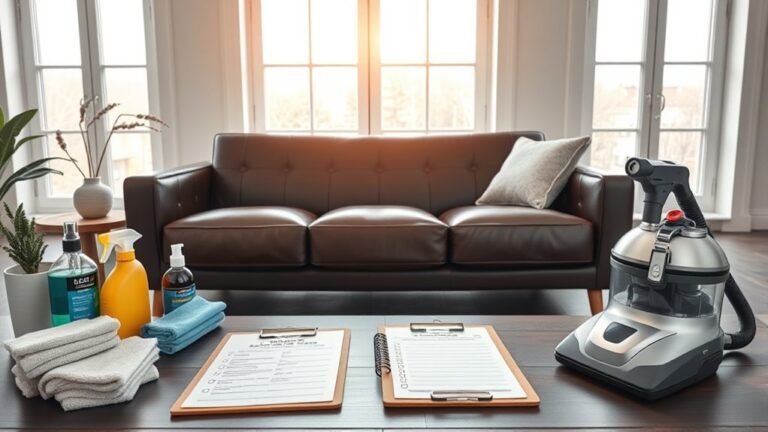How to Clean Blinds and Curtains Without Damaging Them
To clean blinds and curtains without damage, start by identifying their material—wood, fabric, vinyl, or aluminum—as each needs different care. Use gentle tools like microfiber cloths, soft brushes, or a vacuum with brush attachments to remove dust. For fabrics, check care labels, spot clean stains, and avoid harsh chemicals. Wooden blinds need minimal moisture to prevent warping. Regular, gentle maintenance keeps them fresh and extends their life. Keep going to discover specific steps for each type and expert tips.
Understanding Different Types of Blinds and Curtains

Before you start cleaning, it’s important to know what kind of blinds or curtains you have, as different materials require different care. You might encounter various types of fabrics like cotton, linen, polyester, or silk in curtains, each needing gentle or specific treatment. Blind materials can range from wood, faux wood, aluminum, to vinyl. Knowing these will help you avoid damage and keep them looking fresh. For instance, wooden blinds can warp with too much moisture, while delicate fabrics might fade or weaken with harsh cleaning agents. Understanding these types of fabrics and blind materials lets you choose the right cleaning method, so you maintain your freedom to enjoy your space without worrying about ruining your window dressings.
Tools and Supplies Needed for Safe Cleaning
To clean your blinds and curtains effectively, you’ll need a few essential tools like microfiber cloths, a vacuum with a brush attachment, and a soft brush. Using safe cleaning products designed for delicate fabrics or materials will help prevent damage. Let’s look at what you should gather before getting started.
Essential Cleaning Tools
You’ll need a few essential tools to clean your blinds and curtains safely and effectively. Keeping these items handy lets you maintain your window treatments with ease, supporting your cleaning frequency and dust prevention goals. Having the right tools means you can tackle dirt without damaging delicate fabrics or materials, giving you more freedom from constant upkeep.
Here’s what you’ll want:
- Microfiber cloths for gentle, thorough dusting
- A handheld vacuum with brush attachments to reach tight spaces
- A soft-bristle brush for stubborn dirt without scratching
- A sturdy step stool for safe access to high or wide windows
With these tools, you’ll enjoy easier cleaning sessions and keep your blinds and curtains looking fresh longer.
Safe Cleaning Products
Although choosing the right cleaning products might seem straightforward, using safe and gentle supplies is essential to protect your blinds and curtains from damage. You don’t have to rely on harsh chemicals; eco friendly cleaners are a great way to keep your fabrics fresh without risking harm. Look for plant-based sprays or gentle detergents that won’t strip colors or weaken fibers. If you’re into DIY, homemade solutions like diluted white vinegar or mild soap mixed with water work wonders and give you control over what touches your window treatments. Avoid bleach or abrasive agents to maintain the integrity of your blinds and curtains. By opting for these safer products, you preserve your freedom to enjoy clean, beautiful window coverings without compromising their quality.
Step-by-Step Guide to Cleaning Fabric Curtains

Before you start cleaning your fabric curtains, it’s important to prepare them properly by removing dust and checking care labels. You’ll want to use gentle washing techniques to avoid damaging the fabric or colors. Let’s walk through the steps to keep your curtains fresh and looking their best.
Pre-cleaning Preparation
Start by removing your fabric curtains carefully, so you don’t damage the material or the hooks. Before diving into cleaning, complete a preparation checklist to guarantee your curtains stay in great shape. Begin with a fabric assessment—check for any stains, tears, or delicate embellishments that need special care. Next, clear your cleaning space for easy handling and ventilation. Don’t forget to gather all necessary cleaning tools so you’re ready when it’s time to wash.
- Inspect curtain labels for care instructions
- Spot-test a hidden area for colorfastness
- Dust or vacuum curtains gently before washing
- Detach any removable hardware or accessories
Taking these steps gives you the freedom to clean confidently without risking damage.
Gentle Washing Techniques
With your curtains prepped and any delicate areas noted, you can now focus on washing them gently to preserve their fabric and color. Use gentle detergents that won’t strip softness or fade hues. Fill a basin with lukewarm water and add the detergent, then submerge your curtains. For stubborn spots, grab a soft brush and lightly work in circular motions—no scrubbing hard! Rinse thoroughly with cool water to remove all soap. Avoid wringing; instead, press water out gently. Lay flat or hang in shade to dry, preventing direct sunlight damage.
| Step | Tip |
|---|---|
| 1. Choose detergent | Pick gentle detergents |
| 2. Prepare water | Use lukewarm, not hot |
| 3. Spot clean | Use soft brushes lightly |
| 4. Rinse | Cool water, rinse fully |
| 5. Dry | Air dry away from direct sun |
How to Clean Wooden and Faux Wood Blinds
Cleaning wooden and faux wood blinds requires a gentle touch to avoid damage while removing dust and grime. You want to maintain wood care and faux maintenance without sacrificing their natural look or durability. Start by dusting with a microfiber cloth or a soft brush to keep surfaces scratch-free. For deeper cleaning, use a damp cloth with mild soap, avoiding excess water that can warp wood. Remember, faux wood blinds handle moisture better, but still benefit from careful drying.
- Dust regularly to prevent buildup
- Use gentle cleaning products for wood care
- Avoid soaking faux wood blinds during faux maintenance
- Wipe dry immediately to prevent warping
This approach keeps your blinds fresh and lets you enjoy your space freely.
Best Practices for Cleaning Vinyl and Aluminum Blinds

Although vinyl and aluminum blinds are durable and easy to maintain, they still need regular cleaning to keep them looking their best. You can enjoy your freedom from dirt and dust by using simple cleaning methods like wiping with a damp cloth or vacuuming with a brush attachment. Remember, consistent blind maintenance prevents buildup and extends their lifespan.
| Cleaning Method | Emotion Evoked |
|---|---|
| Damp cloth wipe | Satisfaction |
| Vacuum with brush | Relief |
| Soapy water soak | Renewal |
| Gentle scrubbing | Empowerment |
| Air drying | Peace of mind |
Stick to these practices, and you’ll free yourself from tedious chores while keeping your blinds fresh and vibrant.
Tips for Removing Stains Without Causing Damage
Keeping your blinds free from dust and dirt sets a strong foundation, but stains require a bit more care to avoid damage. When tackling stain removal, you want to protect the fabric and maintain its look without hassle. Here’s how you can do it:
Keeping blinds clean of dust is key, but stains need gentle care to protect fabric and appearance.
- Test any cleaning solution on a hidden spot first to verify it won’t harm the fabric.
- Use gentle, fabric-safe stain removers to avoid weakening fibers or colors.
- Blot stains gently instead of rubbing, which can spread the stain or damage the material.
- Work quickly—fresh stains are easier to remove and less likely to set permanently.
Regular Maintenance to Keep Blinds and Curtains Fresh
One simple routine can make a big difference in how your blinds and curtains look and last. By committing to regular dusting, you’ll prevent buildup that dulls their appearance and weakens materials. Use a microfiber cloth or a vacuum with a brush attachment to gently remove dust without hassle. Beyond that, seasonal maintenance is key—take time every few months to assess for stains, damage, or fading caused by sun exposure. Rotate or adjust blinds and curtains to distribute wear evenly, and wash fabric curtains according to care labels to keep them fresh. Staying on top of these small tasks frees you from major cleanings and lets your window treatments stay vibrant and functional longer, giving you more time to enjoy your space.
Frequently Asked Questions
Can I Use a Vacuum Cleaner on Silk Curtains?
Remember when you carefully dusted a fragile antique vase, knowing one wrong move could crack it? That’s how you should treat silk curtains. You can use a vacuum, but with gentle silk care in mind—attach a soft brush, set it on low suction, and glide softly to avoid damage. These vacuum techniques give you freedom to clean without fear, keeping your silk curtains delicate and fresh without risking harm.
How Often Should I Professionally Clean Heavy Drapes?
You should consider drape maintenance frequency based on usage and environment, but generally, heavy drapes benefit from professional cleaning every 12 to 18 months. This schedule helps preserve fabric integrity and appearance. Professional cleaning benefits include deep removal of dust and allergens, preventing wear and tear, and extending your drapes’ life. Keeping up with this routine lets you enjoy fresh, vibrant drapes without worrying about damage or frequent replacements.
Are There Eco-Friendly Cleaning Options for Blinds?
If you’re looking to pamper your blinds with a gentle touch, you’ll be happy to know there are plenty of eco-friendly options. You can embrace biodegradable cleaners that respect both your freedom to choose and the planet’s well-being. Natural solutions like vinegar and lemon juice mixed with water offer a revitalizing way to clean without harsh chemicals. This way, you keep your space fresh while staying true to environmentally friendly habits.
How Do Humidity Levels Affect Blind Maintenance?
You’ll find that humidity control plays a big role in how often you need to clean your blinds. High humidity can cause moisture buildup, leading to mold or warping, meaning you’ll have to increase your cleaning frequency to keep them fresh and damage-free. By managing humidity levels, you’ll enjoy longer-lasting blinds with less hassle, giving you the freedom to focus on what really matters without constant upkeep worries.
Can Pets Damage Blinds or Curtains During Cleaning?
You might not realize it, but your pet’s behavior can turn cleaning blinds or curtains into a tricky challenge. Those curious paws and claws often snag fabrics or bend slats, causing damage before you know it. To keep your freedom intact, take cleaning precautions—like securing pets in another room or distracting them with toys. This way, you protect your window treatments without sacrificing your pet’s playful spirit.






